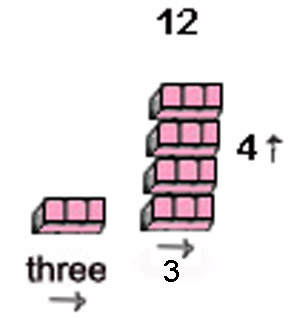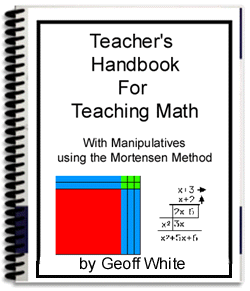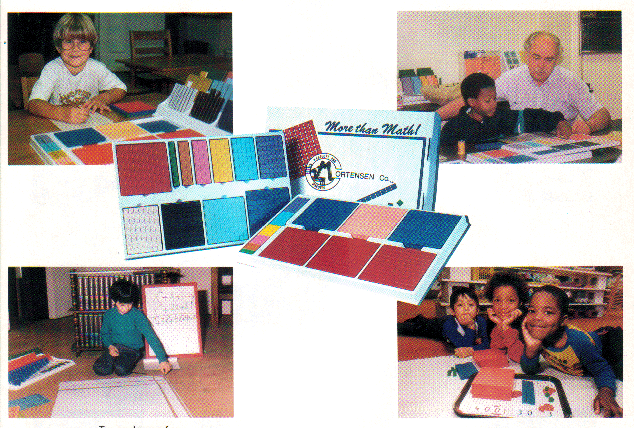
Method is Everything.
by Geoff White, B.Ed. (Southampton, UK)
As Fall approaches, once again parents and teachers focus on how to achieve educational goals.
"How to" are key words, and that points to method.
It used to be said of teaching Physical Education that all you had to do was "roll out the balls" to get it done. Teaching math with manipulatives needs more than "rolling out the blocks" so to speak. If traditional math teaching was entirely memorizing facts, rules, formulae & process, which mystified math and put success out of reach for most, a better method is essential. Teaching math with manipulatives needs an organized approach, a method that employs principles of child-centred learning based on discovery and understanding.
A method has several elements: key language technique, physical steps, sound principles and a means of assessment. We are people and we are all about the senses & the mind. The body rules. It precedes the mind in pace of development. Our manual dexterity evolves more quickly than our mentality. Abstract concepts develop only at the onset of puberty (Piaget) Before that, the body rules. All learning must be sensorial to begin with (Montessori).
Explore and Discover,
is a major theme in Mortensen Math (MM). Originating in Maria Montessori's approach, MM creates opportunities for the child to explore & discover concepts in math by using hands-on activities to acquire experiences from which to build concepts like addition, subtraction, multiplication and division, factoring and problem solving.
"How to" create learning situations is the challenge facing teachers & parents. merely putting the blocks down in front of the child isn't enough. The manipulatives are attractive, nice to touch, made in pretty colours but more is necessary. A child might wave a crayon around, smell it, eat it, scrawl on a wall, but will need direction if recognizable images are expected. Similarly, playing with the child helps to provoke curiousity and to fire the imagination. If you want rectangles built to facilitate rapid accurate counting, one of the principles of MM, you must first demonstrate building a rectangle.
Play is a bonding experience for children. Showing a child something, then saying, "Show me.." is a great way to become involved for an educator. This is how to share experiences and build relationships with the child. Avoid saying "No" or "No, that's not the way to do it." Instead use phrases like, "That's nice, let's try it this way now" or "can we do it this way too?" The point is ALL experiences are learning experiences. "Getting it wrong" is impossible because mastering the world we live in requires that we discover what doesn't work too. Saying "No" in a directed play situation is counter productive. In addition, using the word "No" sparingly, reserves it's power for dangerous situations when immediate response is vital. Don't waste it on the trivial.
Try this. Good! Now, do it again.
Logically, if you ask a child to do something and he makes an attempt we should encourage them because at least he tried. If he hears "no" a lot, he isn't keen to try next time. Rather we should say, "Good. Now let's do it a different way and see how that works," until we get the desired result. Sure, it takes more patience, but the child is worth it. Encouragement results in children who will be eager to try something, rather than having to be coaxed into it every time. They don't want to hear the word no after making an attempt at it. Nobody liikes disapproval. In the long run encouragement works.
For a young child, could having a plastic block named 3 in her hand and counting 4 of them, then counting the unit square markings on the blocks and arriving at 12, be a relevant experience that might lead to understanding?

What use then is memorizing times tables?
MORTENSEN MORE THAN MATH employs manipulatives to enhance the child's ability to visualize math concepts, to decode the mathematical language into spatial reality.
The best way I know to explain the Mortensen Math system is to talk about memory first. How good is your short-term memory? More importantly, how good is your short-term memory with numbers? Suppose I gave you 12 numbers, each of them seven digits long. Do you think you could remember them for an hour? Five minutes? Do you think you could remember them long enough to write them down, even right after I told you?
Not likely. That's because you've been taught like everyone else to memorize the hard way. The hard way is how most students are taught math as well.
The truth is the entire math curriculum used in traditional teaching situations, employing textbooks, relies on memorizing nothing but FACTS, RULES, FORMULAE AND PROCESS!
Our job as educators is to decode this mathematical language of symbols into a concrete reality.
This is what the method does. All is illustrated and explained in the Teacher's Handbook for teaching math with manipulatives using the Mortensen Method.

Order The Teacher's Handbook
for Teaching Math with Manipulatives
In printable .pdf page size 8.5x11, 250pp
Only US$ 65 by Paypal)
To order: send payment by Paypal to me at


Table of Contents The Premise P.1 The Five-Minute Overview of the Method P.8 Key Phrases in Mortensen Math Very Brief Summary of the Method Psychological Principles at Work Introduction - cont'd Create a Math-Rich Environment The Teacher's Role & Student Self-Esteem Six Key Ideas from Jerry Mortensen p.46 Appendices: Section One - Counting Section Two - Addition Section Three - Subtraction Section Four - Multiplication Section Five - Division Section Six - Fractions Section Seven - Algebra Section Eight - Solving Equations Section Nine - Functions & Relations Section Ten - Story Problems Section Eleven - Mortensen Math Program
& Materials P.240
To order: send payment by Paypal to me at


Order The Teacher's Handbook
for Teaching Math with Manipulatives
In printable .pdf page size 8.5x11
Only US$ 65 by Paypal)
To order: send payment by Paypal to me at

